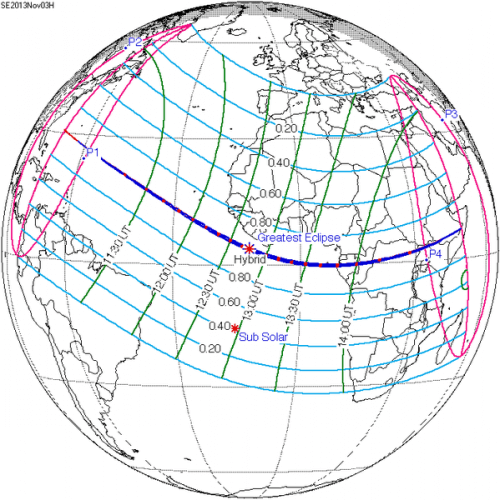The eclipse begins at 15:13 p.m., will reach its peak when the moon covers about 15% of the sun's surface at four o'clock, and will end at 16:43 p.m.

On Sunday, November 3.11, a solar eclipse will occur. The eclipse will only be partially visible from Israel, and in order to watch it you must equip yourself with special glasses (it is forbidden under any circumstances to watch with an unprotected eye!). It begins on Sunday at 15:13 (first contact of the moon's shadow across the sun's disk). The peak of the eclipse is at 16:00, when the sun is already low in the west-southwest direction, and the moon's shadow will cover approximately 15% of it, and its lower left side will look as if it has been bitten by a small bite. The end of the partial eclipse is right near sunset, at 16:43. The next eclipse will occur on April 15, 2014.
Prof. Yoav Yair, a physicist and faculty member in the Department of Natural and Life Sciences at the Open University, adds that this solar eclipse will begin and end as a total eclipse and in the middle will be an annular eclipse. The eclipse will be visible in the western United States, the northern part of the South American continent, the center of the Atlantic Ocean, most of Africa, southern Europe, Turkey and the Middle East. The total eclipse will begin as an annular eclipse eastward from the East Coast of the USA, will become a total eclipse south of the Ivory Coast and will return to an annular eclipse in central Africa until the end of the total eclipse.
Of course, as always a reminder that you should not observe the sun with the naked eye, and you should use a special filter glass for solar eclipses. Another option is to project an image of the sun onto a screen using telescopes with similar filters (otherwise the telescope will burn). Another possibility is to look at the shadow of the tree leaves and see replicas of the partial eclipse on the ground.
An observational experience, Tel Aviv University, 2005
the dragon that eats the sun

7 תגובות
You can watch the sun without risk even by projecting it on a wall with simple household means ("camera obscura"), without a telescope.
You can see how we watched the transit of Venus in 2012 here: http://transit2012.hadaso.net
Arid
Luxor in the middle of the night is still hot. It doesn't seem to me that another 6 minutes of darkness will cause the Nile to freeze... 🙂
Father, the record will actually be in Kentucky and not in the West and it will also last only 2 minutes and 40 compared to over 6 minutes in Luxor. There we will surely need coats in the summer.
Who is organizing for the Western USA, August 21, 2017?
The most significant eclipse in our area will be on August 2, 2027 when at its peak it will cross Egypt, and here we predict over 80% coverage of the sun.
I recommend planning organized transportation to Luxor.
http://eclipse.gsfc.nasa.gov/SEplot/SEplot2001/SE2027Aug02T.GIF
As someone who traveled specifically to watch the total eclipse in Hungary in August 1999 I can testify that it is a wonderful experience. Within seconds Hamsin of 30 degrees dropped to the 20th zone and street lights were turned on at noon.